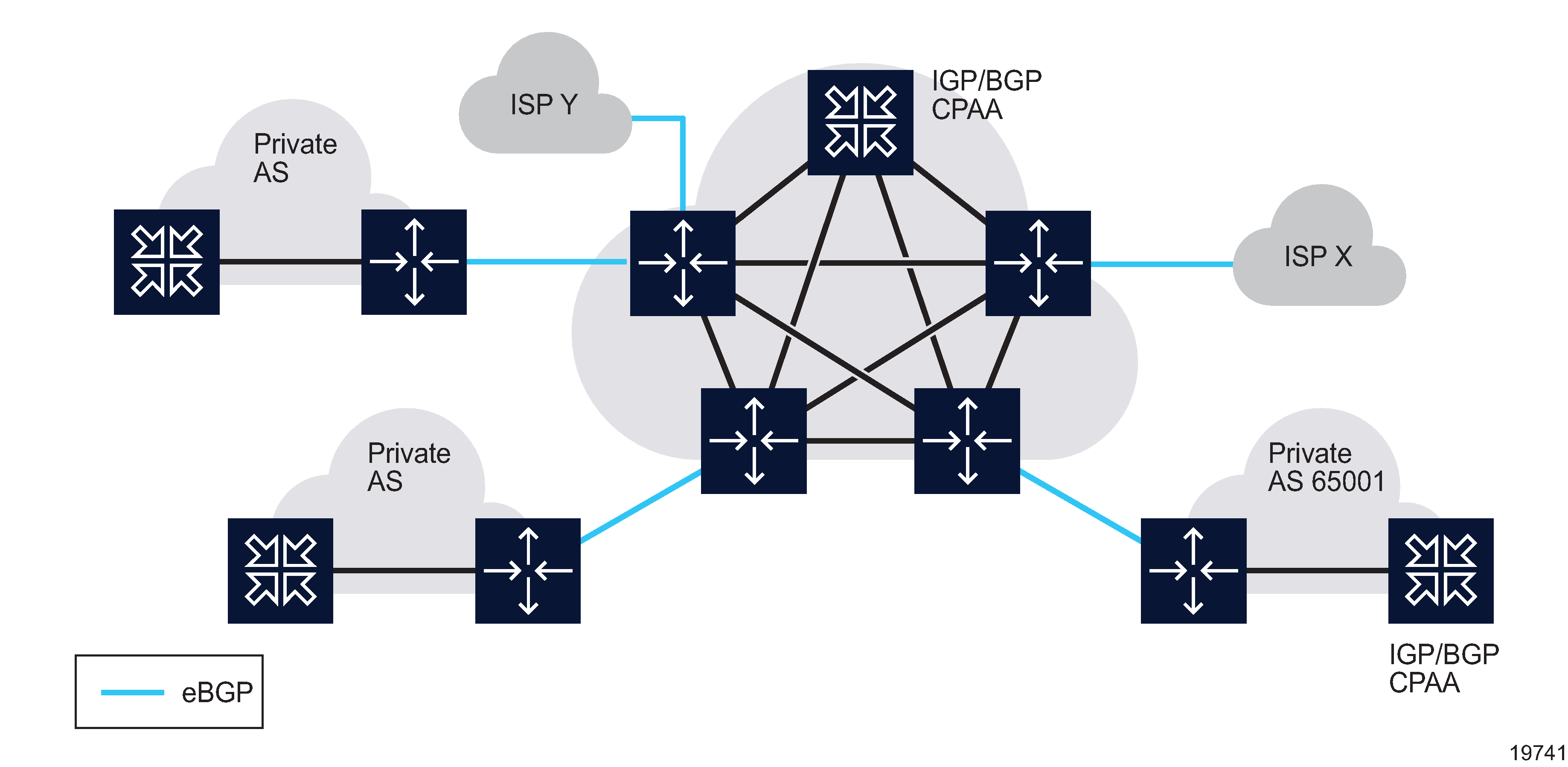BGP topologies in CPAM
BGP AS with meshed IBGP connections
In this topology, EBGP is used between ASs and a full mesh IBGP is created within each AS, as displayed in Figure 10-2, BGP AS with meshed IBGP connections sample topology . The BGP CPAA also has a full IBGP connection to all other BGP speakers in the AS. An IGP administrative domain—an instance of OSPF, ISIS, or both routing protocols—is used in the BGP AS for reachability between routes in the AS and for BGP next hop resolution.
In this case, you use the CPAM to create a BGP AS and an IGP administrative domain for each AS that is managed by the service provider. The BGP AS is assigned the appropriate IGP administrative domain. You can specify a CPAA with both IGP and BGP roles and assign the CPAA to the BGP AS and IGP administrative domains. You can also assign another CPAA to each administrative domain—IGP and BGP.
Figure 10-2: BGP AS with meshed IBGP connections sample topology

Private AS with no confederation
From the perspective of the CPAM, the management of this network is the same as a network with multiple registered ASs, as displayed in Figure 10-2, BGP AS with meshed IBGP connections sample topology . A different IGP administrative domain is associated with each private AS. A BGP CPAA must be assigned to each BGP AS.
In this case, you use the CPAM to create a BGP AS and an IGP administrative domain for each private AS managed by the provider. The BGP AS is assigned the appropriate IGP administrative domain. You can specify a CPAA with both IGP and BGP roles and assign the CPAA to the BGP AS and IGP administrative domains. You can also assign a different CPAA to each administrative domain, that is, IGP and BGP.
AS with route reflectors
The route reflector topology is an alternative to the IBGP full mesh within an AS, when numerous IBGP speakers exchange a large volume of routing information. BGP speakers, or route reflectors, can then advertise IBGP learned routes to IBGP peers. Figure 10-3, AS with route reflectors sample topology shows an AS with four route reflectors. A route reflector along with its client peers forms a cluster. The route reflector redistributes routing updates to all of the devices in the cluster. Because the route reflector provides all of the routing updates, the other devices in the cluster do not maintain a BGP mesh.
You must assign one BGP CPAA to each AS. The CPAA needs a full mesh of IBGP non-client peering sessions to all of the route reflectors and all of the non-client routers. IGP is used for reachability between BGP routers in an AS.
Figure 10-3: AS with route reflectors sample topology

BGP confederation AS with one IGP administrative domain in each sub-AS
This topology is an alternative to the route reflector topology and alleviates the requirement for an IBGP full mesh. The confederation AS is divided into smaller ASs called sub-ASs, as displayed in Figure 10-4, BGP confederation AS with one IGP administrative domain in each sub-AS sample topology . A full mesh of IBGP connectivity exists within each sub-AS. The sub-ASs are connected to each other using the EBGP peering session. Each sub-AS is assigned a private AS number that is only visible within the AS. Sub-ASs are hidden from all of the BGP routers outside the AS. Sub-ASs are visible only inside the confederation AS.
Each sub-AS is monitored by one BGP CPAA. There is a full mesh of IBGP connectivity between the BGP CPAA and all of the other BGP routers within a sub-AS. One IGP protocol is configured in each sub-AS.
In this topology, a BGP sub-AS administrative domain is configured for each sub-AS and a separate IGP administrative domain is created and assigned to each sub-AS.
Figure 10-4: BGP confederation AS with one IGP administrative domain in each sub-AS sample topology

BGP confederation AS with one IGP administrative domain
This topology is similar to the topology described in BGP confederation AS with one IGP administrative domain in each sub-AS . Only one IGP administrative domain is assigned to the entire confederation AS. Each sub-AS is assigned to the same IGP administrative domain.
BGP confederation AS with multiple IGP administrative domains
In this topology, multiple BGP sub-AS administrative domains share one of several IGP administrative domains, as displayed in the figure below. One BGP CPAA is assigned to each sub-AS within the confederation and can also be used to support all or part of the associated IGP administrative domain. In addition, one or more CPAAs can be used for each IGP administrative domain in the IGP topology. If multiple sub-ASs share an IGP administrative domain, only one of the BGP CPAAs can monitor the shared IGP administrative domain. The other BGP CPAAs cannot monitor the IGP administrative domain.
Figure 10-5: BGP confederation AS with multiple IGP administrative domains sample topology

© 2024 Nokia. Nokia Confidential Information
Use subject to agreed restrictions on disclosure and use.